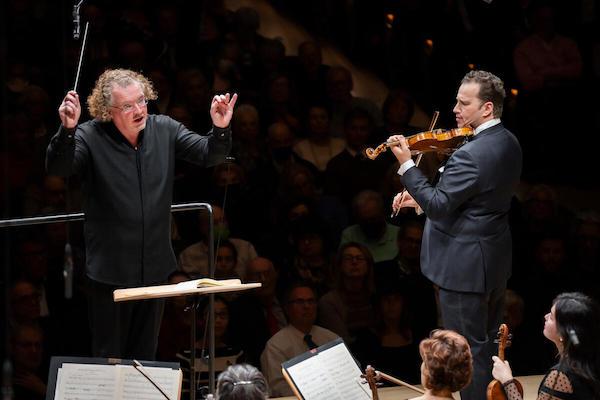Simon work upstages the showpieces at New York Philharmonic

Carlos Simon’s orchestral piece Fate Now Conquers lasts all of five minutes, and feels even shorter. But it was the most arresting thing about Friday night’s concert by the New York Philharmonic, conducted by Stéphane Denève.
Commissioned by the Philadelphia Orchestra in 2019 as counterpoint to a Beethoven symphony cycle—and inspired by a quotation from Homer’s Iliad that Beethoven wrote in his journal—Fate used Beethoven’s orchestra (strings, double winds, timpani) in Beethoven-like sonorities at first, but quickly branched off into contemporary sounds and grooves representing (the composer said) “the unpredictable ways of fate.”
Although the Philharmonic has performed this piece on at least two previous occasions, that feeling of unpredictability, and the music’s high energy in general, seemed to keep the players on the edge of their seats throughout, much to the piece’s benefit.
Quoting the ancient text, Beethoven seemed aware of his place in history and to see some irony in it: “But Fate now conquers; I am hers; and yet not she shall share/In my renown.” Nevertheless, like the poet, he foresaw “some great deed…that all lives shall inherit.”
We have, of course, inherited many musical great deeds from this composer, and in the brief span of his piece Simon paid homage to several of them, beginning with what he called “the beautifully fluid harmonic structure of the second movement of Beethoven’s Seventh Symphony,” then composing music as tightly structured as the first movement of the Fifth, and closing with a fateful thunderclap like the first movement of the Ninth.
According to contemporary accounts, Beethoven’s warm and vital Violin Concerto made little impression at its first performance in 1806. Hard to imagine? Not if you heard Friday’s highly polished but mostly bloodless performance by the Philharmonic with soloist Nikolaj Szeps-Znaider.
As often happens in performances of Classical-era concertos, the orchestral exposition sounded rushed and perfunctory, as if impatient to get to the soloist’s entrance, instead of letting the lovely themes bloom naturally. For his part, Szeps-Znaider played with such silvery tone, impeccable precision and elegant intonation that he sounded reluctant to venture into anything spontaneous, lest he depart from perfection.
Perfection certainly eluded the loose-limbed conductor and his players. The woodwinds played beautifully, both together and individually in duets with the soloist in the second movement. But that movement’s dotted rhythms sounded sloppy, and careless rhythm likewise robbed the finale theme of its bounce.
Inflection points in the score, notably the transition without pause from the second movement to the third, seemed to slide by unremarked. But the finale’s coda teased effectively, and the soloist’s matchless fingerwork was just the ticket for a brilliant finish.
Szeps-Znaider responded to the prolonged applause with a solo encore, elegantly rendering the Sarabande from Partita No. 1 in B minor by J.S. Bach.
Inevitably, Saint-Saëns’s Symphony No. 3 has become famous for including a pipe organ in its instrumentation. Having “the king of instruments” in your symphonic score is a little like having Louis XIV dancing in your ballet—it’s hard not to notice.
But Saint-Saëns, Denève and organist Kent Tritle disguised it well for most of the piece, as it discreetly filled in the orchestral textures, before pouncing at last on the finale’s chorale theme and holding its own, fortissimo, against the Philharmonic’s brass.
In fact, the Philharmonic’s default setting for fortissimo is brassy and strident, and it would have been good to hear something more like the organ’s rich tone from the orchestra as well. The other question after a loud climax is what to do in the softer passages that follow: continue the excitement, just at a lower dynamic, or venture into another expressive realm entirely? Too often, Denève seemed not to decide, but just let the music tick on.
This symphony is in just two movements but many episodes, and one sometimes wondered where the conductor was going with it, particularly during a meandering, Wagner-like Poco adagio in the first movement. Fast tempos and loud dynamics tended to marshal the players, as in the second movement’s Presto dialogue between strings and brass. But conveying an overall impression for a work that is Mendelssohnian in its genteel agitato mood, but like Liszt (to whom it is dedicated) in its transformations of a single theme, was a challenge not fully met on Friday.
Still, in this eventful score there was always something new around the corner, and if one likes one’s fortissimos big, there’s nothing like a symphony orchestra and a large organ both going full blast.
The program will be repeated 8 p.m. Saturday and 2 p.m. Sunday. nyphil.org
Posted Nov 13, 2023 at 12:50 pm by P LK
First, thank you to David Wright for his thoughtful and perceptive review. I too felt that the Beethoven was “bloodless” even with Szeps-Znaider’s marvelous presentation. I also sadly have to agree with Mr. Wright that the orchestra’s “default setting for fortissimo is brassy and strident.” However, I have found them overall to sound better in the new hall. (And, the cello section is magnificent.)
The Simon work was enthralling even if very short. I overheard a couple in the elevator saying that they would like to hear it again—so would I.
I was disappointed with Deneve though I did like him when I heard him with the orchestra a few years ago. I was really looking forward to the Saint-Saens which so rarely gets played. It is a wonderful work. But Deneve seemed to feel that when playing a romantic line, one must make sure to play it very slow at first and then slower the second time around. Of course, the ending of the symphony is a knock-out which even a child could handle.